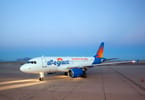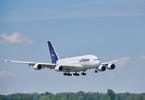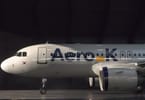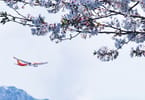The CarTrawler Worldwide Estimate of Ancillary Revenue represents a 264% increase from the 2010 figure of $22.6 billion, which was the first annual ancillary revenue estimate.
Earlier this year, CarTrawler and IdeaWorksCompany reported the ancillary revenue disclosed by 66 airlines for 2016. These statistics were applied to a larger list of 184 airlines to provide a truly global projection of ancillary revenue activity by the world’s airlines for 2017. The CarTrawler Worldwide Estimate of Ancillary Revenue marks the eighth year IdeaWorksCompany has prepared a projection of ancillary revenue activity.
Ancillary revenue is generated by activities and services that yield revenue for airlines beyond the simple transportation of customers from A to B. This wide range of activities includes commissions gained from hotel bookings, the sale of frequent flyer miles to partners, and the provision of a la carte services − providing more options for consumers and more profit for airlines.
| CarTrawler Worldwide Estimate of Ancillary Revenue | |||||||
| 2017
Estimate $82.2 billion (10.6% of global revenue of $776 billion) |
2016 Estimate
$67.4 billion (9.1% of global revenue of $740 billion) |
2015 Estimate
$59.2 billion (7.8% of global revenue of $763 billion) |
2014 Estimate
$49.9 billion (6.7% of global revenue of $746 billion) |
2013 Estimate
$42.6 billion (6.0% of global revenue of $708 billion) |
2012 Estimate
$36.1 billion (5.4% of global revenue of $667 billion) |
2011 Estimate
$32.5 billion (5.6% of global revenue of $577 billion) |
2010 Estimate
$22.6 billion (4.8% of global revenue of $474 billion) |
| Source: Ancillary revenue statistics applied by IdeaWorksCompany to annual airline revenue results. | |||||||
Aileen McCormack, CarTrawler’s Chief Commercial Officer said: “It is terrific to see such healthy growth in worldwide airline ancillary revenue, global online car rental grew by CAGR of 9.3% for the period 2010 – 2016, 7.9% is expected this year and a further 6.9% in 2018 (Source: Euromonitor International Limited 2017 © All rights reserved). These figures indicate that ancillary profits are on a prolonged, upward trajectory and we are delighted to see more airlines looking further than traditional ancillary sources. CarTrawler’s unrivalled industry experience, multimodal transport solutions and pioneering technological advances have allowed our partners to adequately develop their supplementary revenue streams, making us an invaluable asset to any airline.”
Revenue from optional services, such as onboard sales of food and beverages, checked baggage, premium seat assignments, and Wifi access, was determined to represent $57 billion of the estimated 2017 global total ($44.9 billion for 2016). The remaining $25.2 billion comes from non-fee activity such as the sale of frequent flyer miles to program partners, and commissions earned on the sale of car hire, hotel accommodations, and travel insurance ($22.5 billion for 2016).
Analysis performed by IdeaWorksCompany during the past seven years reveals natural airline groupings (or categories) based upon a carrier’s ability to generate ancillary revenue. The “percentage of revenue” results associated with four defined categories have been applied to a worldwide compilation of operating revenue disclosed by 184 airlines.[1] The following describes the four categories:
- Traditional Airlines. This category represents a general category for the largest number of carriers. Ancillary revenue activity may consist of fees associated with excess or heavy bags, extra legroom seating and partner activity for a frequent flyer program. The average percentage of revenue increased by nearly one percentage point to 6.7% from 5.8% for last year. Examples in this category include Cathay Pacific, Copa Airlines, Etihad Airways, and Iberia Airlines.
- Major US Airlines. US-based majors generate strong ancillary revenue through a combination of frequent flyer revenue and baggage fees. The percentage of revenue for this group jumped to 14.2% for 2017 from last year’s 12.3% and was likely due to an expansion of bundled fare offers and ever-growing frequent flyer revenue. Examples in this category include Alaska, American, Hawaiian, and United.
- Ancillary Revenue Champs. These carriers generate the highest activity as a percentage of operating revenue. The percentage of revenue achieved by this group leapt to 30.9% from 25.5% for 2016. The size of the increase can be attributed to higher results from the big carriers in this category: Frontier, Ryanair, Spirit, Vietjet, and Wizz.
- Low Cost Carriers. LCCs throughout the world typically rely upon a mix of a la carte activity to generate good levels of ancillary revenue. The percentage of revenue for this group remained for a second year unchanged at 11.8% for 2017. Low cost carriers include Brussels Airlines, China United Airlines, Condor, Interjet, and Jazeera Airways.
| CarTrawler Worldwide Estimate of Ancillary Revenue – by Carrier Type for 2017 | |||
| Airline Category | Total Ancillary Revenue | Frequent Flyer & Commission Based | A la Carte Activity |
| Traditional Airlines | $32.1 billion | $9.6 billion | $22.5 billion |
| US Major Airlines | $24.6 billion | $14.3 billion | $10.3 billion |
| Ancillary Revenue Champs | $17.7 billion | $0.9 billion | $16.8 billion |
| Low Cost Carriers | $7.8 billion | $0.4 billion | $7.4 billion |
| Global Totals | $82.2 billion | $25.2 billion | $57.0 billion |
| Source: Ancillary revenue statistics applied by IdeaWorksCompany to 2016 airline revenue results. | |||
With few exceptions, airlines all over the world are moving to a la carte methods to provide more choices for consumers while boosting ancillary revenue. The pace of ancillary revenue activity quickens when major alliance members, such as Air France/KLM, American, Lufthansa, Qantas, and United embrace ancillary revenue methods. The changes have a ripple effect through the oneworld, SkyTeam, and Star Alliances which encourages member airlines to adopt the same methods to smooth commercial and operational connections.
There are many other reasons for 2017’s big revenue boost. Airlines labeled as “ancillary revenue champs” represented $4.1 billion, or 28%, of the 2017 increase. These airlines have built networks that now offer attractive options for business travelers. Fare bundles that provide more flexibility, better seating, and fast track service at airports have been developed to lure commercial customers from traditional airlines. In addition, frequent flyer program benefits are now a common feature for airlines in this category, such as those offered by AirAsia, Frontier, Jetstar, Norwegian, Pegasus, and Spirit.
The following highlights specific activities recently taken by key ancillary revenue champs to attract more business travelers:
- AirAsia added a 24-hour business-style airport lounge at its Kuala Lumpur home to attract more premium passengers.
- EasyJet achieved a 14% increase in flexible business fare sales during 2016.
- Jetstar introduced its “Business Hub” booking site and FlexiBiz bundle for corporate agents and business travelers.
- Ryanair is among the top tier of airlines for offering a total of 16 a la carte products to reach corporate travel agencies via Amadeus, Sabre, and Travelport.
Not to be forgotten, US major airlines contributed $4.6 billion to the increase for 2017. The growing threat of low-cost carriers has prompted these airlines to aggressively adopt a la carte methods. Basic economy pricing, which does not include a checked bag, is now universally offered in the US domestic market. American Airlines has already said it’s considering adding these fares to transatlantic markets, which will prompt others to consider the same. Frequent flyer programs in the US continue to generate ever-increasing revenue for US major airlines as a result of renegotiated deals with issuing banks and the attraction consumers continue to show for co-branded cards. The ongoing push for better ancillary revenue performance from booking sites, mobile apps, and travel agency distribution networks will ensure even better results for US major airlines for 2018.
This partially explains why the largest share of the 2017 increase came from the world’s traditional airlines at $6.1 billion, which was 41% of the total increase. For example, throughout North America, Europe, and Australasia, basic economy fares are now prevalent for short and medium haul travel. Airlines using this a la carte approach usually find more than 50% of passengers select higher priced bundled options. When this activity is matched by an ever-growing pool of airlines, the result is billions more ancillary revenue.
The graph below represents the likely distribution of ancillary revenue for traditional airlines outside the US. Admittedly, it’s difficult to create a pie graph to display the wide variation for traditional airlines throughout the world, such as an Iberia in Europe or Singapore Airlines in Asia. In addition, the distribution of revenue sources is different for US airlines; these have a far larger slice representing the sale of frequent flyer miles. Meanwhile, a depiction of revenue sources for almost any low cost carrier would notably display less revenue from a frequent flyer program.
Ancillary revenue tops $20 per passenger for 2017
IATA predicts nearly 4.1 billion passengers will spend $776 billion worldwide on air transport for 2017. Applying the global ancillary revenue estimate to IATA’s statistic yields a result of $20.13 per passenger. IATA also estimates the airline industry will spend $129 billion on fuel during 2017. It’s reasonable to suggest ancillary revenue will someday exceed the airline industry’s annual fuel bill. It’s amazing to view bag fees as a meaningful hedge against the price of jet fuel.
At the rate of $20.13 per passenger, ancillary revenue continues to contribute mightily to industry profits, which IATA predicts will be $7.66 per passenger for 2017 (net post-tax profits). It’s startling to recall that ancillary revenue on a per passenger basis was just $8.42 in 2010. Even the a la carte portion of today’s $20.13 amount (which removes the contribution of frequent flyer programs and commission-based activities) is a very meaningful $13.96 per passenger. That figure has come a long way from the $4.54 per passenger a la carte portion in 2010.
The economic boon of ancillary revenue has proven to be a highly useful tool to fix airline finances. It delivers profit-boosting results during times of severe economic distress, and works effectively to lift profits even higher when airlines are achieving investment-grade margins. But airlines should tread carefully. A la carte pricing works best when consumers are truly free to choose the product that best meets their needs. Good retail practice ensures the ability to easily remove unwanted products from a shopping cart and place them back on the shelf. But some carriers continue to treat ancillary revenue as an opportunity to simply charge new fees without creating a better product. Fortunately, a la carte pricing magnifies the power of the marketplace to reward good value and punish bad products. This year’s global increase illustrates that principle admirably.
WHAT TO TAKE AWAY FROM THIS ARTICLE:
- Ancillary revenue is generated by activities and services that yield revenue for airlines beyond the simple transportation of customers from A to B.
- The CarTrawler Worldwide Estimate of Ancillary Revenue marks the eighth year IdeaWorksCompany has prepared a projection of ancillary revenue activity.
- These statistics were applied to a larger list of 184 airlines to provide a truly global projection of ancillary revenue activity by the world's airlines for 2017.






















